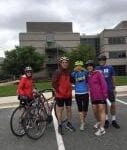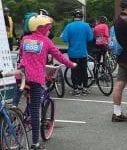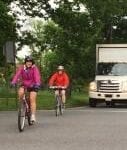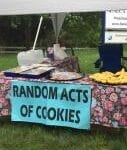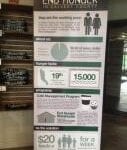Written by Thu Tran, MD,FACOG
May 9, 2017

Last Saturday, six of us participated in a 27 mile bike ride – the Tree House’s Tour de Cookie. Tree House is a nonprofit organization with the mission of public investment in foster children, the most vulnerable children in our society. This Tour de Cookie ride is especially fun, as there’s a cookie stop every few miles to replenish our energy. We probably took in more calories eating cookies than burning them through the ride. We rode through the hilly roads along North Potomac, Maryland. Five of us also participated the weekend before in Calvert County’s Calvert End Hunger Ride. We rode in two different Maryland counties with the purpose of raising funds for fighting poverty in the county.
I have a very soft spot for children, as many of my friends would tell you. I believe all children, in an ideal world, deserve a peaceful childhood, as adulthood brings many challenges and decisions. Children deserve some carefree years where they can explore the world and build trust that their existence is important and the world is full of kindness and fairness. Children deserve a happy childhood because they were born not by their choice. Half of the people in our country don’t even believe women should have choice between bringing children into the world, ending or even avoiding their pregnancy with help if they don’t think they can adequately care for these children. These citizens should also believe in helping these children born “without a choice” progress in their life.
Did you know there were almost 416,000 foster children in 2015? The statistics on foster children and the effects and outcome of being in foster care would make any of us parents quite sad for these children.
North Potomac is part of Montgomery County, one of the most wealthy counties in the U.S. We rode past mansions with beautiful gardens secured behind iron gates, many of which we could not see from the road, as they were hidden behind long driveways lined with huge trees and shrubs. I saw many grand English-style homes with horse barns and flower gazebos, the kind of homes I did not see last week when I rode on the Calvert End Hunger ride in Calvert County.
Calvert End Hunger ride was a 35 mile bike ride through the beautiful country roads in Southern Maryland, dotted with small ranchers and bungalows. The surrounding woods were full of wild flowers, with Wisteria vines cascading down from enormous poplar trees. Part of the ride was along the picturesque Chesapeake Bay. There were more American flags and pickup trucks parked in the front lawns than along the homes in North Potomac. There were still campaign signs of “Trump/Pence” fluttering in the wind. It was, I jokingly told my friends, the “JD Vance” area of Maryland where people are more conservative, more “red” than “blue.”
I learned so much about poverty participating in these charity rides. I learned how hunger exists in Calvert County even when this county is the nineteenth most wealthy county in America. Calvert County is not too far from Washington, D.C. We do not have to go far to witness hunger. See the photo attached to this blog to learn about the statistics of Calvert County Hunger. Most hungry people in this county are working, not homeless or unemployed as many of us would believe.
I was horrified a few days ago to learn how half of the U.S. counties have this “lunch shaming” practice, where children’s lunches are compromised or not given when their parents did not pay on time for their lunches. Some of these children might not be poor, but many have parents who can’t afford to pay for their children’s school lunches at all. Reading the New York Time’s editorial on this subject shocks me that hunger in poor students still exist in this wealthy nation more than forty years after I arrived.
Many people in our society believe, unfortunately, that poverty is the result of personality flaws. I am one of those who believe we are not “natural-born” socialists, but might evolve that way when we witness injustice. This social transformation was discussed in a recent New York Time’s article “Inequality Isn’t The Real Issue.” This article was written by a group of Yale psychologists as part of a paper they recently published in the Journal of Nature Human Behavior.
In the article, this team of psychologists found that inequality in wealth distribution, for example, was not the source of outrage in most people; it’s the unfairness leading to this inequality that bothers many of us. The authors believe how policy makers and activists fight against inequality because they fear for the negative consequences that this inequality will create in society. They fight for “injustice” and not so much inequality. They pointed out another study discussed by Princeton philosopher Harry Frankfurt in his book “On Inequality.” Dr. Frankfurt found, for example, how people are not bothered by the vast difference between the very rich and the very, very rich, even if this difference is greater than that between the poor and the moderately well-off. Clearly, it’s not the inequality in itself that’s the issue.
When a poor, hungry student scores lower on his SAT than a well fed, SAT-prepped privileged student, is it injustice? This is a question we should reflect on. In my opinion, these two students were not on equal footing. Cycles of poverty and inequality perpetuate unless we all reflect on these issues and see how we can help those disadvantaged.
Solving economic inequality is complicated, sparking so many heated debates that divide our country into “red” and “blue” zones. Harvard Economic Professor Sendhill Mullainathan, in his New York Time blog “To Help Tackle Inequality, Remember the Advantages You’ve Had,” which I strongly recommend you to read, mentions a Gallup Poll conducted over 30 years, which shows consistently how a majority of Americans believe in a more even distribution of wealth but cannot agree on how to achieve this equality. Professor Mullainathan believes people tend to have a “psychological bias” of remembering clearly the obstacles they overcame to achieve their success but forgetting the advantages given to them. He explained this bias in terms of “headwinds” and “tailwinds,” with headwinds being the vivid memory or overrepresentation of one’s life obstacles, while tailwinds are the advantages or resources given that help propelling someone to success.
Professor Mullainathan states how he himself tends to immediately recall the challenges he faced along his way to earn his doctorate at Harvard, while often forgetting the best educational resources given to him by his family as compared to other children in India to get him to that achievement. He believes this tendency of remembering only the “headwinds” in our life leads us to explain the failure of others as stemming from a lack of perseverance. By thinking of our “tailwinds,” we will have more compassion toward the poor. Poverty, Mullainathan believes, is not only caused by strong “headwinds” or obstacles, but by a lack of “tailwinds” or advantages.
Two rides in two different counties confirm how “little” people like us can make a difference in our community and country at large. Do not wait for the great government to create “tailwinds” for the poor. Do not let the great government divide our people into segments of “Us” and “Them.” While the “important” citizens are playing their real life chess games with ordinary citizens being their pons, debating which war to start or end, which segment of society deserves more help, which law they should pass to make sure they get reelected at the next cycle, we little people should take actions to widen the happiness index in our society. Feed the hungry children, alleviate some burden of poor people so they can take time to be better parents to reduce the number of foster children. Nobody wants to be poor or unhappy by choice. The recent federal budget proposal of a 21% funding cut to the U.S. Department of Agriculture (USDA) would not be a sensible way to create “tailwinds” for poor people to improve their life, as it would affect funding for school lunches. If we can’t even afford to feed our children while the very, very rich folks are about to get their windfall tax cut, who are we in the eyes of the free world? My friends and I could pedal 35 miles to donate a meager amount of money to feed the hunger in Calvert County, but our legs won’t be strong enough to pedal for $150 million expected cut to care for the poor.
In the news about “Lunch shaming,” it was reported how poor children had to even witness their rich classmates throwing away part of their lunches. Maybe some of these poor children will remember this event as an injustice, and will try to play however a small part they can in their adult life to help solve the problem of inequality.
At every charity event, there’s always something that strikes me deeply. Today, at one of the cookie stops during our 27 mile ride, a simple sign did it. This sign struck me deeply enough that I called out to my friend Dr. Seidelman to stand next to it, so I could snap a photo for her. Marsha, like me, strongly believes in the quote on that sign: “No Kindness, No Matter How Small, Is Ever Wasted.”
Us, and them
And after all we’re only ordinary men.
Me, and you.
God only knows it’s not what we would choose to do.
Forward he cried from the rear
and the front rank died.
And the general sat and the lines on the map
moved from side to side.
Pink Floyd
Tags:




